When the second Canadiana auction (hosted by Walter Duralija’s eBay store, International Collectibles Exchange) ended on June 8, the talk of the comics community was the record price achieved for the first Canadian comic book, Better Comics # 1. This CGC graded 5.5 rarity sold for an incredible $18,100 USD. According to Ivan Kocmarek’s analysis, this is the highest price ever achieved for a Canadian comic book.
More than two hundred Canadian comics and pop culture collectibles were sold during the auction. There were a few other surprises, such as the high price achieved for a gorgeous Jim Steranko Cosmicon poster ($711 USD), but after sifting through the results I feel that most of the sales were in line with expectations and there were even some items that sold for less than what I expected.
As a case in point, some criminally underrated scarcities from the early Canadian Silver Age were available and went for absolute steals. These comics were listed as parts of two loosely connected lots of 1970s comics from Ontario. Given my ongoing multipart series about the emergence of comics fandom in Ontario, I thought it would be worth mentioning the low prices achieved here before using them as a springboard for discussing the wider contributions to the development of Canadian comics stemming from the work of Vincent Marchesano, Art Cooper and Spectrum Publications.
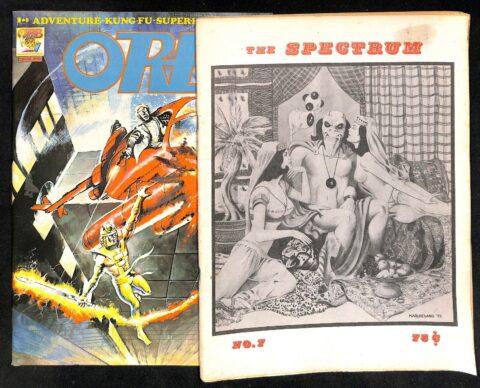
Both of these lots included copies of Orb Magazine # 5 and The Spectrum # 7. While I recommend the issue of Orb, it is a common comic that is generally available for sale. On the other hand, The Spectrum # 7 is a comic that does not come to market often and is actually something that I have been hunting for. The lot that included just these two comics sold for $9.99 USD. Somebody got a good deal.
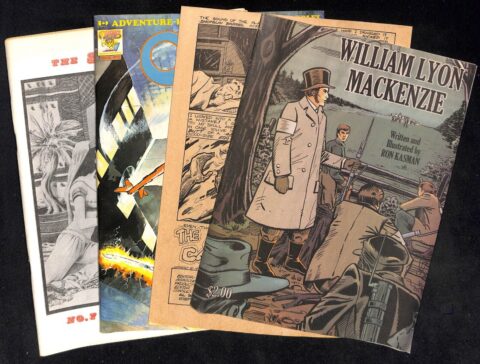
The other lot also included Art Cooper’s very rare comic The Crap Caper featuring Samuel Strong, as well as Ron Kasman’s comic William Lyon Mackenzie, which is also hard to find. The four comics sold for just $24.50 USD. I own a copy of The Crap Caper, which I was able to source many years ago with a bit of luck. I have only ever seen this comic come to market a handful of times and this is the cheapest I have ever seen it sell for. The same goes for these copies of The Spectrum # 7, which is the only issue of the series that I do not own. I don’t own a copy of William Lyon Mackenzie and am kicking myself for missing out on this particular lot. I mixed up the dates. Mea culpa.
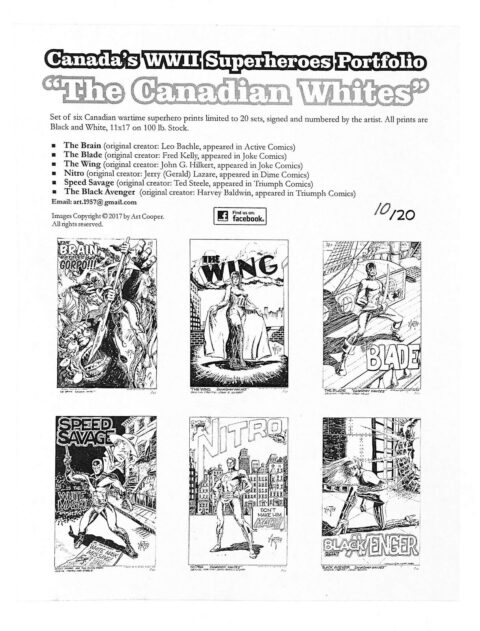
One of Art Cooper’s Canadian Whites portfolios also sold during the auction. It was originally available as part of the Kickstarter for Ivan Kocmarek’s book Heroes of the Home Front. This portfolio is absolutely gorgeous and was limited to just twenty copies. When I backed the Kickstarter, I was one of the people who selected and received this portfolio, which I still own today. I was surprised to see this very limited item sell for $17.50 USD as part of the auction.
I have long felt that Spectrum Publications is the most underrated company that published comics during the formative years of the Canadian Silver Age. Using this name, Marchesano and Cooper continued to create content in the years after their earliest works were published in collaboration with Terry Edwards. With the exception of The Spectrum # 7 (which is magazine size), all of their comics were released as minis. In fact, their comics were the very first independent mini-comics published in Canada that I know of (Ganes Productions was already publishing giveaway minis for their corporate and government clients). Spectrum published three series over the course of a couple of years in the early 1970s and was, for all intents and purposes, one of the key progenitors of science fiction and fantasy comics in Canada. This month, it is my pleasure to provide readers with a broad overview/checklist of the comics that were published by Spectrum in the early 1970s.
All three of Spectrum Publications’ fanzines debuted in 1971. The first series, The Spectrum, launched the company in March 1971. It was edited by Vincent Marchesano, with Art Cooper being credited as the assistant editor. In the introduction to the fanzine, Marchesano explains that he had originally promised a different fanzine two years earlier, but that it did not come to fruition and that backers of this previous project would receive the first two issues of The Spectrum instead. Marchesano used his introduction to ask readers to send him their own artwork or scripts to help fill out future issues. He also offered poster prints of Stan Lee for sale, as well as custom 35mm slides of comic books using his photography skills. Future issues would advertise poster prints of Marchesano and Cooper’s artwork too while continuing to ask for submissions.
The first issue of The Spectrum consists of a single eleven-page story called “Man Amongst Men” written and laid out by Cooper with artwork by Marchesano and based on a plot from Ed Reece. The comic concludes with some fan art and original pieces by Cooper and Marchesano. With this first comic Spectrum Publications was born and would set the stage for a nearly two-year run as one of the most interesting things happening in Canadian comics.
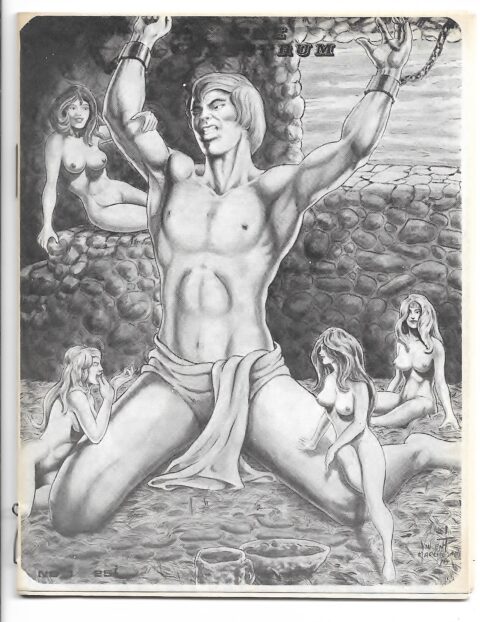
Marchesano and Cooper released their second series, the portfolio zine With Pen and Brush, in May 1971. This fanzine consists entirely of one-page pieces of fan art of Golden Age characters like Doll Man, the Black Terror and the Black Canary. Almost all of the artwork in With Pen and Brush # 1 is by Marchesano and Cooper, but there are a couple of drawings by a person who could be either Bob or Jim Garrison.
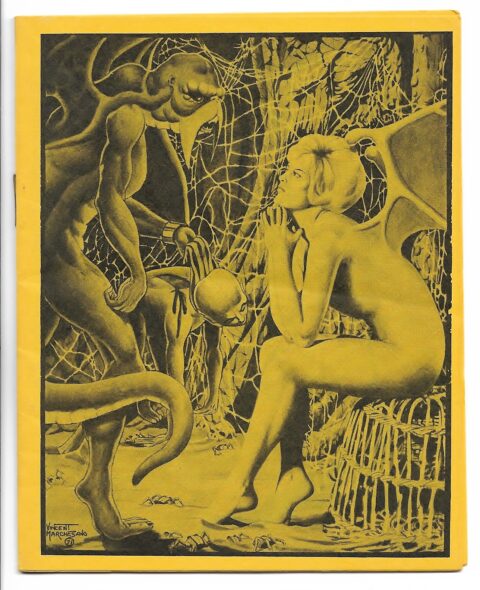
In the introduction to The Spectrum # 1, Marchesano announced his intentions for the series to be released bi-monthly. At first, he and Cooper were able to stick to this schedule and in May 1971, The Spectrum # 2 debuted. The second issue of the series includes three short comic stories: “I Am Mad” by Marchesano, “The Origin of Satan” by Cooper, and “Look George, Food!” The latter story was written by Frances McCrone (who I assume was a reader who sent in a script) with artwork by Marchesano. Issue # 2 of The Spectrum also features the debut of the fan letters section called “Spectragrams,” which would subsequently be released as its own letter zine.
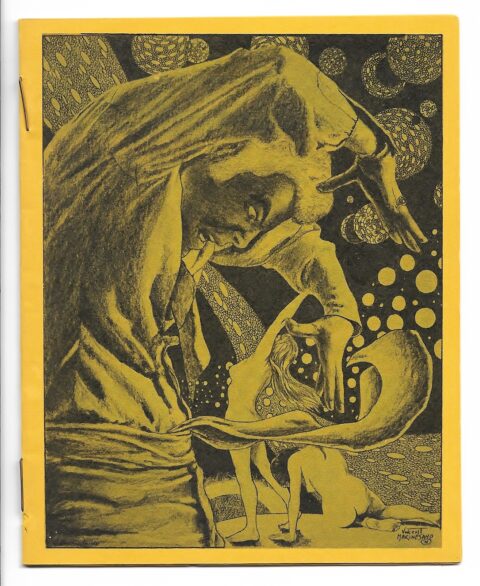
After publishing two zines in May 1971, Spectrum Publications would not be able to stick to its bi-monthly schedule. July came and went without new issues of either series, but both With Pen and Brush # 2 and The Spectrum # 3 would appear in August/September 1971.
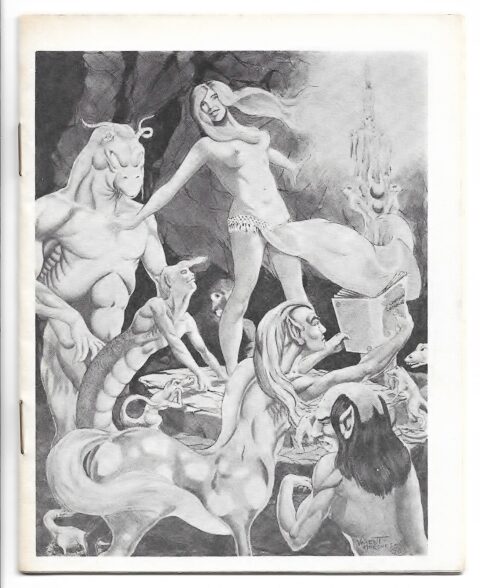
The new issue of With Pen and Brush continued to be a vehicle to publish Cooper’s artwork, but this time around included artwork from several readers. At least one contributor, Mark Ammerman, was releasing his own comics in the United States during this era such as The Wonderful World of the Wild and Wicked West. Another artist, Michael Stevens, has several pages of artwork printed here. Other contributors include Dan Meastrom and S.D. Lahie, as well as additional artists whose names I cannot make out. Unfortunately, I have not been able to learn anything about these fan artists.
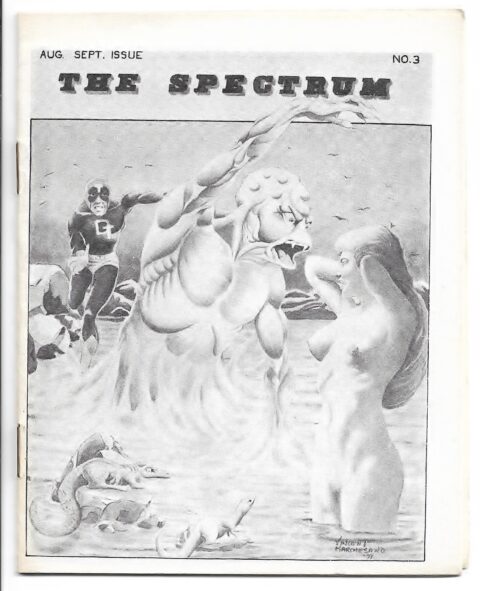
The third issue of The Spectrum is dedicated to Jim Steranko, whom Marchesano thanks for, “the encouragement that he has given me and for making my stay at the New York Convention enjoyable.” The issue debuts the superhero character Dr. T with a twelve-page story that makes up the entirety of the issue. The story was scripted by Terry Edwards, who makes his Spectrum Publications debut, with the plot and artwork by Marchesano.
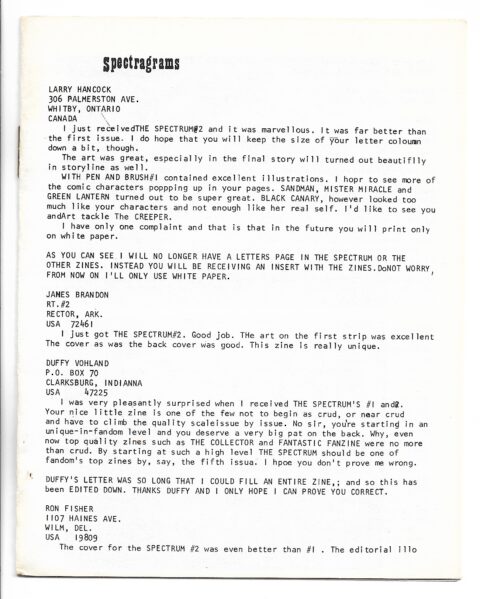
We also learn in The Spectrum # 3 that Marchesano has decided to print Spectragrams as a separate zine that will be included as an insert in issues of The Spectrum moving forward. I believe that four issues of Spectragrams were published and included as inserts with issues # 3-6 of The Spectrum. The letters in the first issue of this new insert make it clear that this decision was made in response to the negative reaction to The Spectrum # 2, which included numerous fan letters at the expense of original stories and artwork.
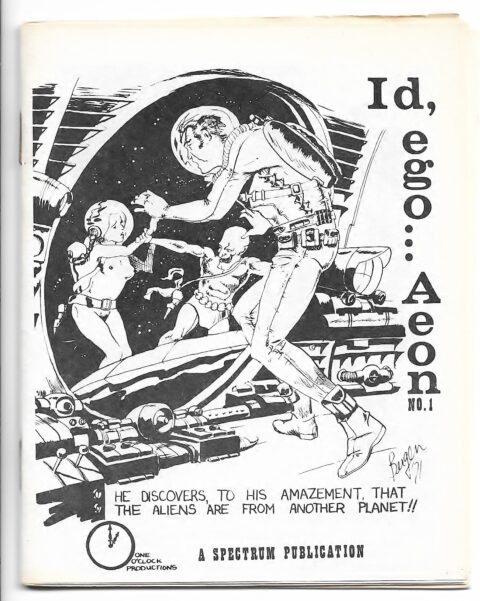
Also, of note from The Spectrum # 3 is that it offers a glimpse at the first issue of the final series released by Spectrum Publications: Id, Ego…Aeon. Unlike the other two series released by the company, this series was edited by Cooper with Marchesano being credited as assistant editor. The first issue of the series is undated, but I assume it was released in either August/September 1971. The comic features a long, twenty-one-page story featuring the character A-7 written by Cooper and Terry Edwards, with Cooper, Marchesano and Judy Bergen contributing artwork.
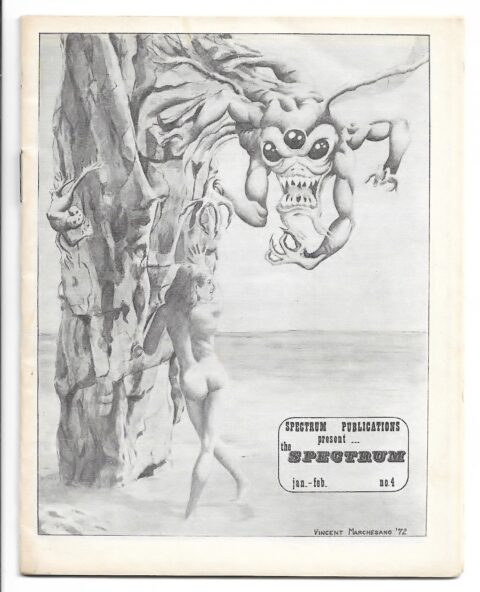
The next batch of releases from Spectrum Publications would appear in January/February 1972. All three of the fanzines would feature new issues during this two-month span. This time around, the indicia from The Spectrum # 4 no longer promises bi-monthly releases. Instead, the fanzine would now be released five times per year. Issue # 4 of The Spectrum is dedicated to Marchesano’s new bride, Joanne, who is pictured in a wedding photo on the back cover. The comic features a ten-page story by Marchesano called “A Journey,” with a three-page backup story called “The Garden” by writer Jim Delaney, artist Ron Jamieson and letterer Al Torj. Jamieson also had artwork appear in issues of the Canadian fanzine Comic & Crypt around the same time.
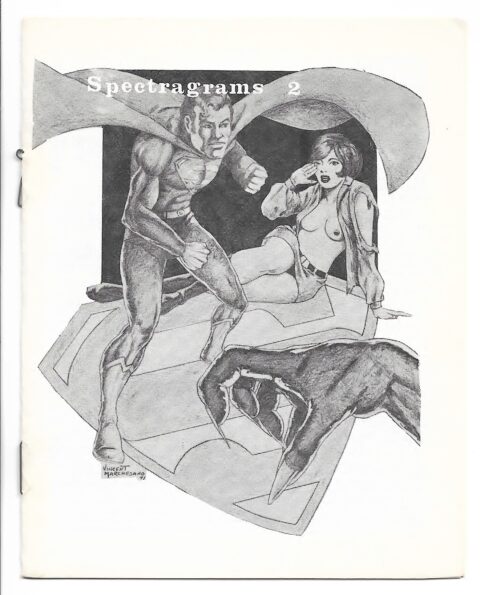
Comic & Crypt is also advertised on the back cover of Spectragrams # 2, which was included as an insert with this issue of The Spectrum. This time around Spectragrams features a cover by Marchesano and a short letter by Ron Kasman, who would go on to become a well-known Canadian comic creator in his own right. We learn through the letters that readers were critical of Id, Ego…Aeon # 1 because of the A-7 story being too long and hard to follow. From what I understand, Cooper dropped A-7 moving forward.
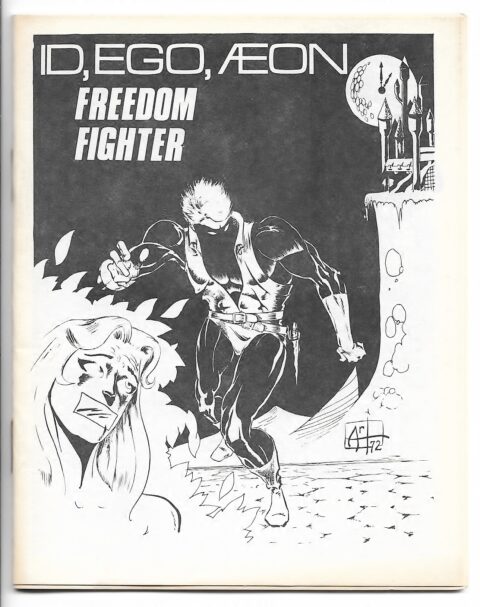
Nevertheless, Cooper moved forward with a second issue of Id, Ego…Aeon in January/February 1972. Acknowledging the mistakes of the first issue, the new comic features three short stories focusing on the character Freedom Fighter, who had previously appeared in 1969’s Canada’s Best Comics. The same team of Cooper, Marchesano, Edwards and Bergen returned for this issue, with Mauro Martini joining the fold. Martini had previously contributed to Edwards’ Comicanada # 2 in 1968. Cooper also contributes a four-page backup story called “Warning” to round out the comic.
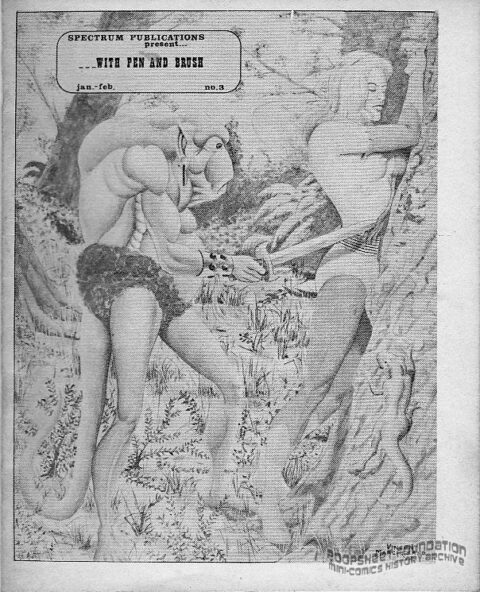
Unfortunately, I do not own a copy of With Pen and Brush # 3, but thanks to Rick Bradford and Brad Middleton from the Poopsheet Foundation I am able to share the cover here. Apparently, all of the artwork in this issue depicts American Golden Age characters and is by Marchesano.
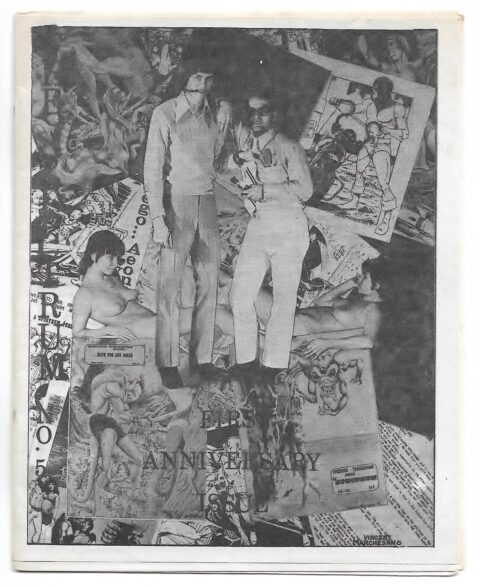
Marchesano was able to stick to the intended publishing schedule in order to release The Spectrum # 5 in March/April 1972. The issue includes a nine-page strip featuring Marchesano’s new series “Destiny’s 5,” as well as a four-page Freedom Fighter backup story by Cooper, Bergen, Edwards and Marchesano.
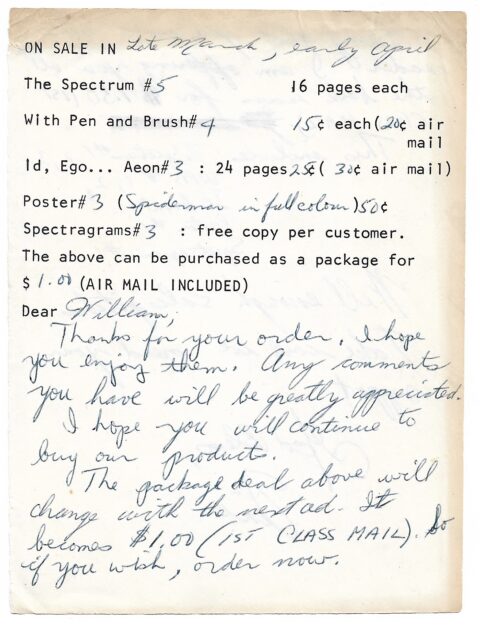
Although I do not own either Id, Ego…Aeon # 3 or With Pen and Brush # 4, I know that both were released during March/April 1972 because of a handwritten receipt issued by Marchesano to a customer named William that includes these other zines. I have never seen a copy of With Pen and Brush # 4, but I assume that it is the Jack Kirby issue that was promoted in some of the other Spectrum Publications releases. From what I understand, Art Cooper took over as editor with this issue of the portfolio zine.
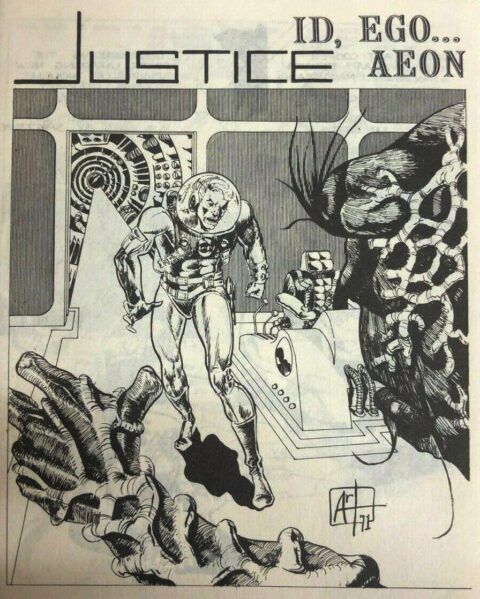
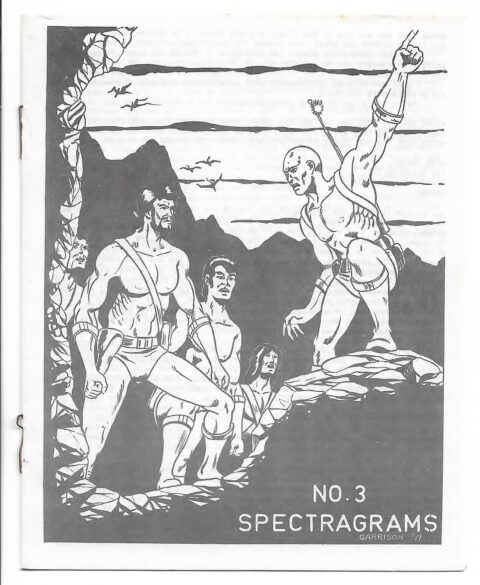
After this batch of fanzines was released in March/April 1972, Marchesano and Cooper announced that they would not be releasing any fanzines until July/August in order to take a vacation and attend the New York Convention. Spectrum Publications would then return with new issues of all of their fanzines, but this was the beginning of the end. With Pen and Brush # 5 and Id, Ego…Aeon # 4 would be the final issues of each series. I believe that Spectragrams also concluded with issue # 4 as an insert with The Spectrum # 6.
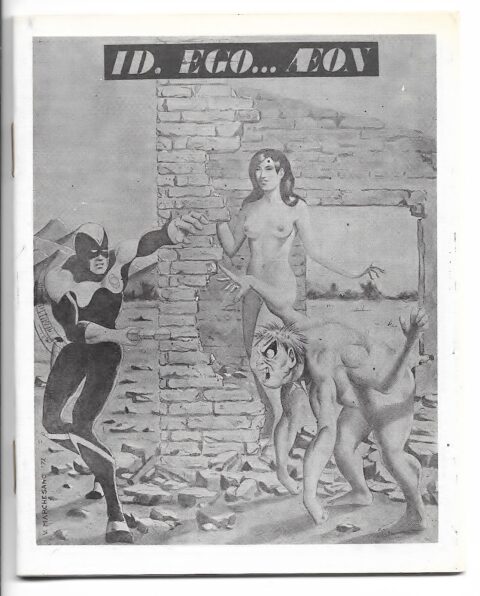
Id, Ego…Aeon # 4 features a twenty-two-page story, “Vicon of the Skyriders,” written and drawn by Vincent Marchesano based on a character created by newcomer Ron Fortier (you can check out his website here). It is arguably the most ambitious strip released by Spectrum Publications. In his introduction, Cooper promises that issue # 5 will debut his most exciting character yet, but this appears to have never come to fruition. Fortier would also contribute to The Spectrum # 6 and would go on to have a long career in comics, including his run with Alex Ross in 1990 on Now’s Terminator: The Burning Earth.
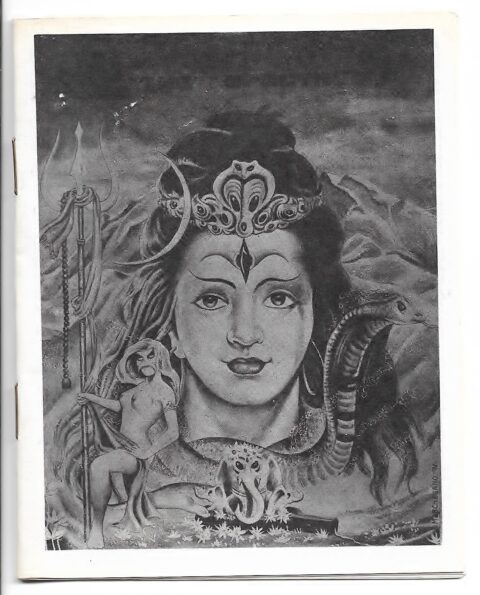
Issue # 6 of The Spectrum also promised big things. Captain George Henderson contributes to the series for the first time with a two-page strip drawn by Marchesano called “Zoltan, The Destroyer.” A four-page Freedom Fighter story called “Pay Your Dues” written by Fortier, drawn by Cooper and lettered by Bergen serves as the backup story.
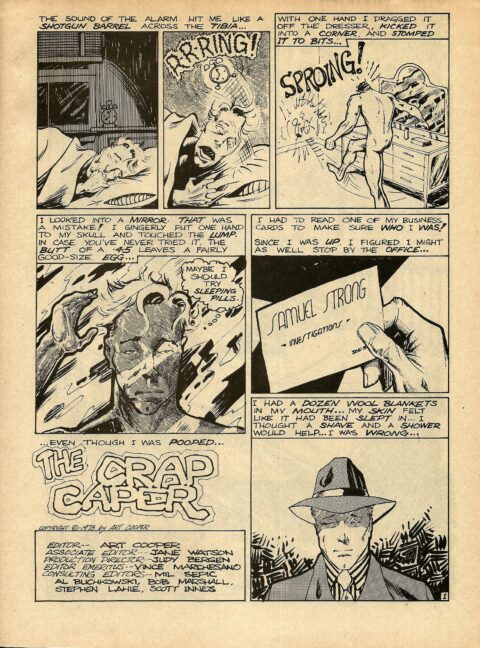
The issue also debuts Cooper’s adaptation of Leslie Herbert Green’s The Perfect Crime starring Samuel Strong (with lettering by Bergen). The character would return in 1978’s The Crap Caper, which was self-published by Cooper and was originally intended to be The Spectrum # 8. Cooper set the record straight when commenting on one of my articles back in 2019 when I first suggested that Marchesano should be considered for the Canadian Comic Book Hall of Fame. The comic was printed coverless and paid homage to old Will Eisner’s The Spirit strips. Cooper stated that the comic originally included an “editorial” sheet explaining this. Unfortunately, I do not have a copy of this with my specimen of The Crap Caper/The Spectrum # 8. Marchesano was not involved with this comic, but because it was originally supposed to be an issue of The Spectrum is credited as “Editor Emeritus.”
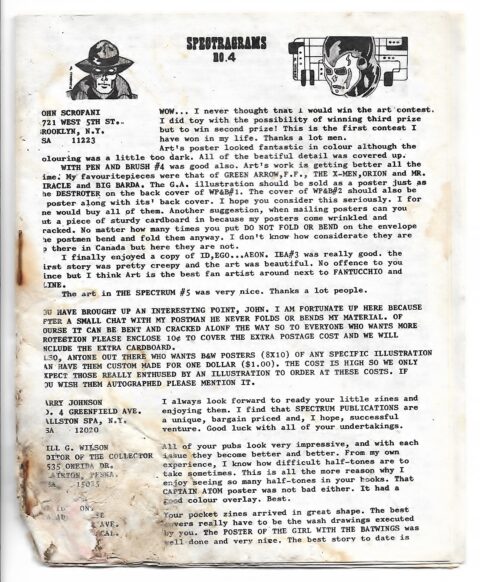
The fifth and final issue of With Pen and Brush would be Cooper’s last as editor of this fanzine. According to his introduction in the issue, the series was supposed to continue with Mil Sepic of Saskatoon taking over as editor. It seems that this never came to fruition. This time around numerous people contributed art to the portfolio zine. In addition to Cooper and Marchesano, as well as the returning Michael Stevens, this issue features an impressive array of artwork by well-known creators including Ron Kasman, Ronn Sutton, Terry Eaton, Jim Garrison, John G. Fantucchio and a young Brad Foster.
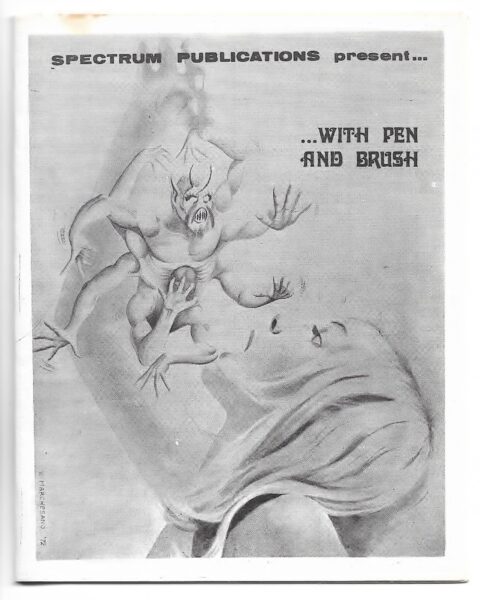
I am not sure when The Spectrum # 7 was released, but I suspect that it was either towards the end of 1972 or the beginning of 1973. Afterwards, Spectrum Publications came to an end. Marchesano managed to reprint several Spectrum Publications stories in a one-shot called Space Fantasies in 1973 for the California-based publisher Fantasy House. He also contributed to the publisher’s only other comic, Infamous Funnies, before it ceased publication the same year.
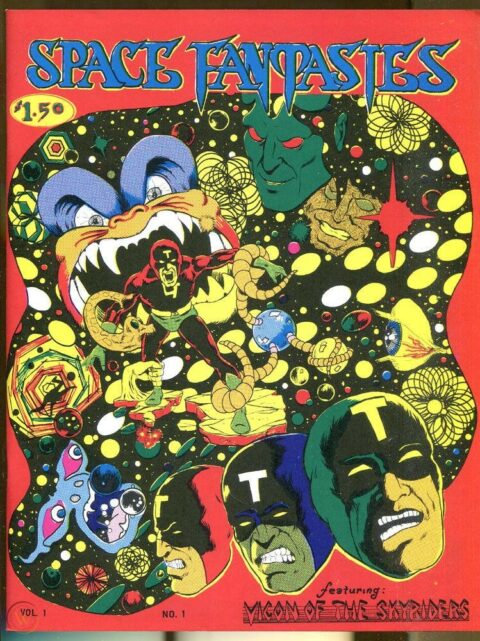
Marchesano and Cooper would both start contributing to James Whaley’s great Canadian science fiction anthology comic magazine, Orb, beginning with issue # 4 in 1975. Marchesano would draw the character Dark Ninja for the final three issues of the series, while Cooper would draw the character Kadaver in issues # 4 and 5.
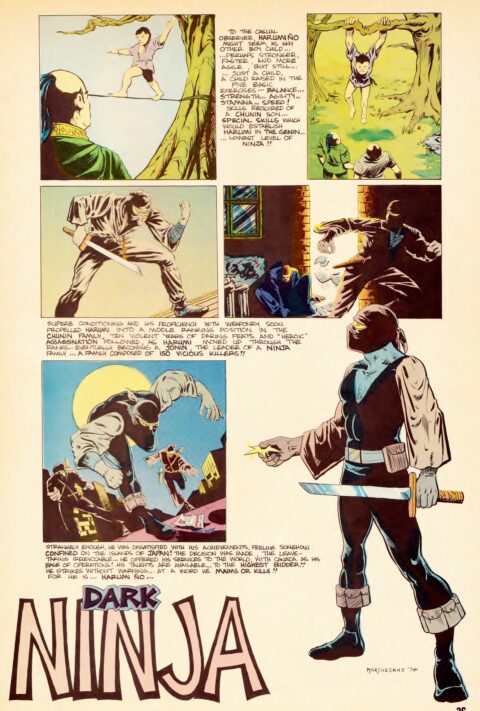
Both Marchesano and Cooper continue to be involved in and champion Canadian comics to this day. I cannot overstate the importance of these two men to the development of comics in Canada (and particularly Ontario). It is my hope that by showcasing the comics and zines released by Spectrum Publications that these men will receive the attention that they deserve. Their comics are getting harder and harder to find but still fly under the radar, as the recent Canadiana auction demonstrates. Issues of their minis only had print runs of three to four hundred issues. They are rare and I suspect that this is the only reason that they have been overlooked. I think that their work speaks for itself.

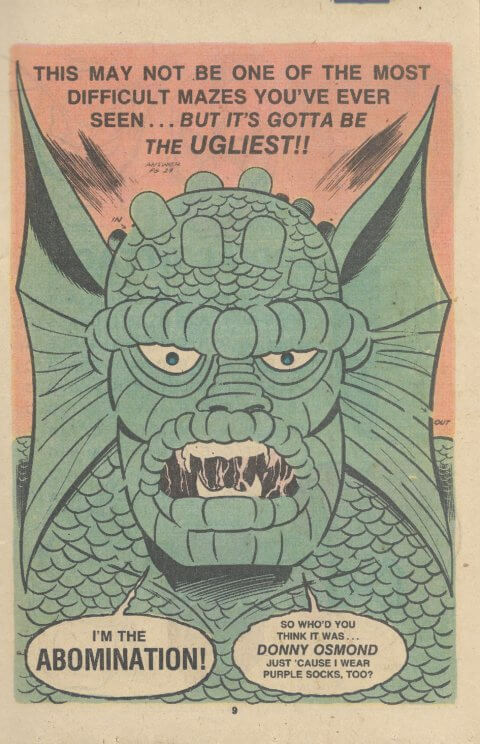
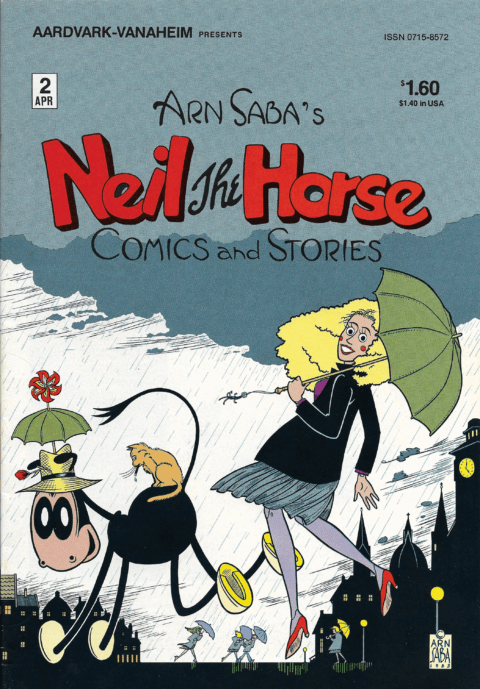
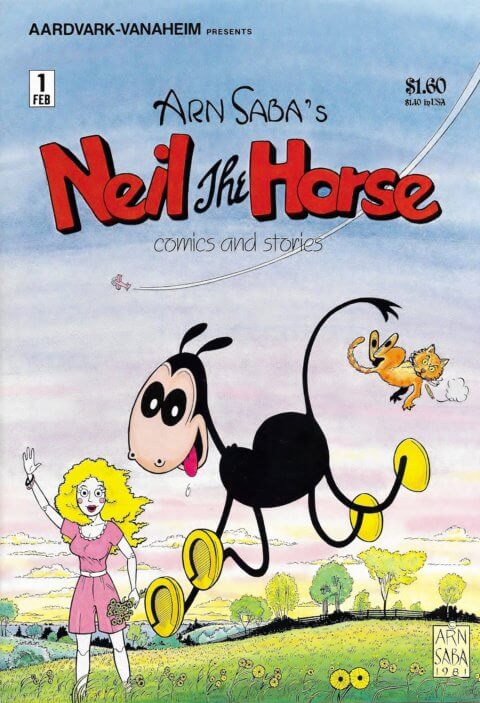
Vincent’s art showed incredable improvement over the years. His Dark Ninja is superb.
Thanks for commenting, Klaus. I agree that Marchesano’s artwork improved significantly over time. I didn’t mention it in the article, but his work on issue # 9 of the Charlton Bullseye is quite polished and is worth checking out too.
Excellent article as usual, Brian!- your work really needs to be collected in a tangible form, such as a nice reference book that we can put on our book shelves.
The cover of ‘Id, Ego…Aeon # 1 from 1971’ struck me, as I have seen that image before. Being a devout collector of Charlton comics, I know I have seen that image on the cover of one of their space books. A quick trip to Grand Comics Database proved my hunch as accurate!- The cover of ‘Id, Ego…Aeon # 1’ is a swipe from the cover of OUTER SPACE #20 from December 1958, originally by Dick Giordano. All Judy Bergen did was erase the silly alien in the original & add the new figures in the doorway. Nice to know that some parts of my memory still function!- I have not looked at my copy of Outer Space #18 for at least twenty years !
‘I have not looked at my copy of Outer Space #18 for at least twenty years !’- my error, that should be Outer Space #20, but then, I have a copy of #18 as well & I really need to look at that too…
Good call LF! Apparently these folks had as little regard for copyright as George Henderson! It looks like they just whited out the alien face and stole everything else with the little addition of a scantily clad woman and an alien. This is an out and out rip off, I’m afraid. They probably thought they could get away with it because Charlton’s distribution in Canada was always pretty spotty, so fewer people were likely to catch this than a blatant rip off of DC or Atlas. Shame on them!
Good eye, Live Frog. Here’s a link to a picture of Outer Space # 20 from the Grand Comic Database for those who are interested. I had no idea that Bergen’s cover was a blatant rip off.
https://www.comics.org/issue/215895/cover/4/
Swiping is nothing new & is as old as the wind. I have a ‘thing’ for science-fiction covers that show a creature coming through a portal, airlock or doorway and simply recognized this image. Frank Frazetta’s Famous Funnies #213, Ditko’s Space Adventures #12 & Wolverton’s Weird Tales of the Future #5 are comic covers that simply turn my crank ! I liked Giordano’s Space Adventures #20 cover EXCEPT for the silly alien. Most Charlton artists generally failed in creating interesting monsters & their efforts are ho-hum bland, Ditko being an exception.
The study of swiping in comics or pulps is very interesting & FICTION HOUSE alone will keep you busy for some time. Fiction House re-used cover designs over & over again, and the same images appear on both their comics and their pulps with minor changes. Everybody’s favourite Spicy pulp publisher [ Culture/Trojan ] is also known for re-working their covers, sometimes taking a completed cover painting & re-painting certain areas in order to arrive at a ‘different’ image- these nasty guys did this to defraud their artists from getting paid again for work that Culture was re-using! Boo Hiss! Has anyone written a comprehensive book on the publishing history of the Spicy pulps ? I don’t think so, as these guys were so shady I doubt much information survives.
Culture/Trojan was a part of the DC publishing empire. I am surprised that DC is not capitalizing on the Spicy pulps fame to publish some new SPICY stories. I would love to see a SPICY CATWOMAN comic on the shelves & would buy several copies of SPICY WONDER WOMAN stories [SPICY SENSATION COMICS ???] , especially if they were a little bit saucy ! Thigh high red boots & lassos anyone ???
Sorry Brian, I seem to have diverted a little bit. Story of my life …..
Thanks for the kind words, brian, and the extensive and comprehensive review. It’s too bad this comments field doesn’t accept images, or I would have posted the original Spectrum #8 Cover for ‘The Crap Caper’. It’s gratifying to think that the 4″ x 5″ fanzines we produced as kids are actually appreciated by fans all this time later. It may not seem obvious, but the amount of work producing two 16 pg. books (Spectrum and With Pen & Brush), a 24 pg. book (Id, Ego, AEon) and the 8 pg. Spectragrams meant we were putting out a total of 64 pages of material while I was a full-time student and Vince had a full-time job. We had help, but between us provided most of the material, and Vince did all the production work to get the books to the printer.
I should clarify one point — you mention that Vince or I was listed as Editor on various issues, but really, it was a completely collaborative effort, so that division between the books is not as it seems. You will note that in some cases, books edited by one of us might have contents primarily by the other.
One minor quibble, you didn’t mention the 8 1/2″ x 11″ color posters that were an integral part of the ‘Spectrum Package Deal’. Between the color separations (done by Vince) and the extra negs and plates, the posters were the equivalent of an additional 16 pg. book in terms of printing costs.
Ah, the good old days…
LF
Well, you’re right about how shady some publishers were back then. You have to remember that they got much of their paper shipped in from Canada in trucks that frequently hid booze in the front of the thing and packed paper behind it. No border guard in his right mind would want to unload an entire truckload of something as heavy as paper on the off chance their may be bootleg liquor hiding behind it. You also have to remember that many of these companies bought their paper from the likes of Meyer Lansky and Bugsy Siegel, among other rather questionable characters.
Just quickly, there are at least 10,000 copies of William Lyon Mackenzie in circulation. It was part of James K. Bartleman’s crusade for literacy. It came out in a paper and a leather bound edition. I have only one copy of the leather bound ones.
Thanks for commenting, Art. Minor quibbles aside, I hope that you are happy with this overview of your minis. I had a great time reading them again and I am glad to have had the opportunity to present the material here. My apologies for not providing more information about the posters. I didn’t have any images on file and this article was already much longer than what we aim for at Comic Book Daily, so I decided to omit discussing them from this article. Maybe I can write about the posters in a future column.
On the subject of the posters (and considering the minis that you and Vince published), it is important for younger readers to consider how much time and effort went into publishing this material compared to a decade and a half later when many creators had easy access to photocopiers. These Spectrum Publications minis (and posters) would have been much more time consuming and expensive to pull off.
Art, if you like, please message me through Facebook at the East Coast Toys and Games business page (@eastcoasttoysandgames). I will happily include a picture of the Crap Caper cover in my next column if you can send the image to me.
Also, I am curious about you comment concerning who was referred to as “Editor” from zine to zine, as both of you receive the title of Editor at different points. Reading the zines, it is clear to me that these were entirely collaborative efforts. I think that Vince says something to that effect in his introduction to The Spectrum # 5. Yet, when I was reading all of the zines again as I was preparing this article, I wondered whether or not The Spectrum was originally supposed to be Vince’s project, while Id, Ego…Aeon was intended to be yours. Either way, almost immediately it seems like the lines between the two zines became quite blurred in terms of who was working on what. Could you elaborate?
Cheers, brian
LF
I forgot to add that one of Harry Donnenfeld’s best friends was Frank Costello, so he may have enjoyed connections with both the Italian and the Jewish mobs of the time. Alan Moore would probably tell you that not much has changed!
Hi brian, your surmise was correct:
Vince, who I will say up front was the publisher, and did the lion’s share of production and print prep work, including, you might like to know, shooting the negs, which were 4″ x 5″ because he had access to a 4″ x 5″ camera at work, which is what defined the final size of the books, created the original Spectrum book, and then, because contributions from outside were primarily spot illustrations, came up with the ‘With Pen & Brush’ portfolio ‘zine, was hogging all the glory, and I wanted a vehicle for my own work, on the off-chance that I got any extra stuff done. (At this point, I feel I should be nominated for some sort of prize for ‘Longest Run-On Sentence’…)
So, yes, IEAE was ‘my book’, but once we got the whole ‘Package Deal’ rolling, that quickly changed to each of us fitting stuff in as best we could. My only point was that the title of ‘editor’ didn’t really have a lot of meaning.
You are correct, it was a lot of work / fun. I don’t really understand how we could have gotten in done while fulfilling our ‘regular’ full-time commitments. I sure can’t get anything done now…
Vince and Art were an inspiration for both the quality and the quantity of their work. I loved getting their fanzines in the mail.